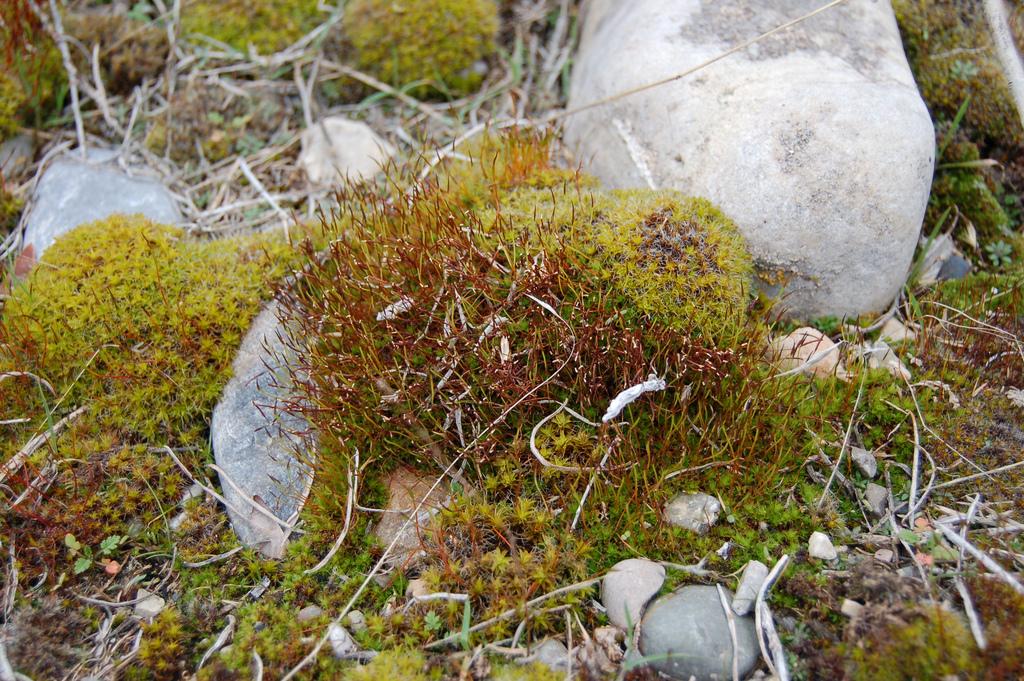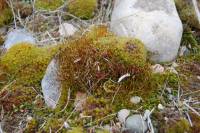Plants forming cushions, green, occasionally blackish green distally, yellow-brown to dark brown proximally. Stems usually to 2 cm, occasionally branching; rounded-pentagonal in transverse section, hyalodermis generally absent; sclerodermis absent, central strand present; rhizoids often dense; axillary hairs ca. 5-8 cells in length, basal 1-3 cells thicker-walled. Leaves appressed-incurved to lax when dry, weakly to widely spreading when moist; obovate to spathulate, ovate to elliptical, occasionally ligulate, adaxial surface nearly flat to concave, broadly channeled, occasionally grooved along costa, 1-4(-6) mm; base scarcely differentiated to elliptical; margins recurved proximally or rarely plane, entire or occasionally serrulate near apex, margins occasionally with 1-4 cell rows often less papillose and smaller, walls thicker; apex broadly acute to rounded, lamina inserted laterally or to 45° on costa; costa short- to long-excurrent as an awn, occasionally percurrent or subpercurrent, adaxial outgrowths rarely present as an elliptical pad of cells bulging from adaxial costal surface, adaxial cells quadrate, papillose or smooth, in 3-4(-5) rows adaxially, abaxial cells short-rectangular to elliptic, papillose or smooth; transverse section of costa circular to semicircular, adaxial epidermis present, adaxial stereid band absent [occasionally small], guide cells 2(-3) [absent], in 1(-2) layers, hydroid strand present, often large, abaxial stereid band present, rounded, elliptical, or semicircular in sectional shape, abaxial epidermis present, occasionally present only laterally, rare absent; basal cells reaching across leaf or rising higher medially, rectangular, 18-25 µm, 2-5:1, walls thin, hyaline; distal laminal cells rounded-quadrate to hexagonal, occasionally rhomboidal, distal laminal cells ca. 15-19 µm wide, 1:1-2, papillae mostly hollow, simple or 2-fid, 4-6 per lumen, occasionally on conic salients, cell walls thin, seldom evenly thickened, superficially convex. Specialized asexual reproduction by brood bodies on rhizoids [gemmae on leaves]. Sexual condition dioicous or monoicous (commonly autoicous or synoicous); perichaetia terminal, inner leaves little different or somewhat larger than the cauline. Seta yellowish brown or brown, very short to 2.5 cm, twisted counterclockwise or not twisted. Capsule usually stegocarpic, occasionally cleistocarpic, yellowish brown or dark brown, spheric, ovate, el
The transfer of the type species of the former genera Desmatodon, Phascum, and Pottia to Tortula, and the redistribution of many of the species of these four into new and resurrected genera by R. H. Zander (1989, 1993) was based largely on characteristics of the gametophyte. The rationale was that reduction easily explains the inclusion of cleistocarpic, eperistomate, and peristomate capsules in one genus, while lumping of very different, complex gametophytic traits into one genus is less easily supported. Species of the flora area previously in Tortula having, among other characters, leaves red in 2% KOH solution, have been transferred to Hennediella, Microbryum, or Syntrichia. The reasons proposed by J. Guerra and M. J. Cano (2000) for erection of the genus Protobryum for Tortula protobryoides are not compelling. This species has the gametophyte of closely related species in Tortula. The sporophyte is not unique (see discussion below) and has an intermediate and possibly hybrid nature (nondehiscing annulate and peristomate).
The stem leaves of this genus are usually characterized as being lax, with lax and more delicate cell walls than species of Syntrichia. Tortula species are delicate in appearance, characteristically light green, with smooth awns, with a gradual transition in form from medial to basal laminal cells, the papillae are generally low and sometimes apparently absent, and the costa has a rounded or semicircular abaxial stereid band section. Species of Syntrichia are more coarse in habit, a dark green to red-orange laminal color in nature, with smooth or serrulate awns, with usually an abrupt fenestration of the basal laminal cells, the papillae are usually evident and strongly differentiated, and the abaxial stereid band is lunate in section. Tortula is remarkably homogeneous with respect to the gametophyte. The sporophytes are notable, however, in the apparent reduction series of capsule and peristome development, ranging from complete cleistocarpy, incomplete stegocarpy, the peristomes being absent, many variously absent, rudimentary to well developed. Of the well-developed peristome structures, included are peristomes with low to high basal membranes, the variation more likely due to different degrees of retraction of the capsule mouth than to teeth fusion, peristome teeth that are short and erect, to longer and oblique or inclined to fully el
Excluded Species:
Tortula wilsonii (Hooker) R. H. Zander
This uncommon species of Europe, Asia, and northern Africa was reported for British Columbia by T. T. McIntosh (1989) from a specimen that proved to be a species of Pterygoneurum, possibly new, with rather variable expression of the costal lamellae, dense papillae on the medial cells, and a triangle of smooth rhomboid cells comprising the erose leaf apex, possibly the same as that reported but not described by B. M. Murray (1992).




